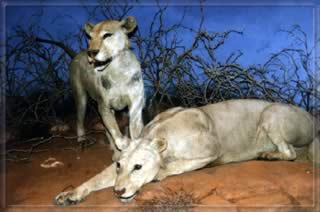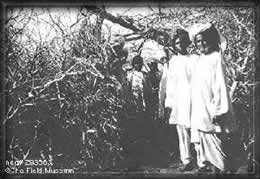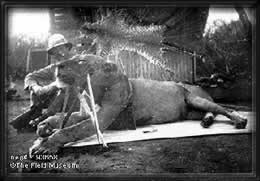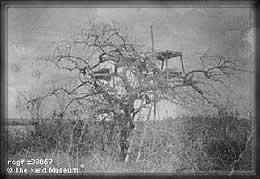

 March
1898 : Colonel J.H. Patterson is appointed to take charge of the construction
of the Tans - Uganda Railway and to build a bridge across the Tsavo River. The
engineering problems alone are monumental; the worst problem, however, is not
of human origin - it is two mighty, man-eating lions. The lions hunt with such
a methodical precision that the Africans believe they are the devil in person
and call them the ' Ghost ' and the ' Darkness ' .
March
1898 : Colonel J.H. Patterson is appointed to take charge of the construction
of the Tans - Uganda Railway and to build a bridge across the Tsavo River. The
engineering problems alone are monumental; the worst problem, however, is not
of human origin - it is two mighty, man-eating lions. The lions hunt with such
a methodical precision that the Africans believe they are the devil in person
and call them the ' Ghost ' and the ' Darkness ' .
The problem begins when a Sikh named Ungan Singh is seized in his tent during
the night, dragged off and eaten. Patterson, who is skeptical about the rumors
that man eating lions are in the area, investigates the death of the Sikh. He
finds paw prints plainly visible in the sand, and the furrows made by the heels
of the victim are very evident. Now, convinced, he starts to track down the
animals.
This is the beginning of a tragedy which almost caused the termination of the
Trans - Uganda Railway.
 The
following night Patterson lurks in a tree near the remains of the Indian, hoping
the lions would return. This time, however, the brutes seize a victim from another
camp. The next night he takes up his post in a tree near the second scene of
crime. He ties a goat below to the tree, hoping to entice the lions to return.
But, about midnight, he hears the screams and cries of yet another victim.
The
following night Patterson lurks in a tree near the remains of the Indian, hoping
the lions would return. This time, however, the brutes seize a victim from another
camp. The next night he takes up his post in a tree near the second scene of
crime. He ties a goat below to the tree, hoping to entice the lions to return.
But, about midnight, he hears the screams and cries of yet another victim.
The lions seem to have the uncanny ability to avoid any traps Patterson may
set.
 Every
night Patterson tries to scout the location of the lions, or trap them, but
to no avail. To protect the workers from the ferocious ravages of the man-eaters,
very high, thick thorn fences were constructed around each camp site. The lions,
however, managed to jump over or break through these fences seemingly with impunity
and disdain.
Every
night Patterson tries to scout the location of the lions, or trap them, but
to no avail. To protect the workers from the ferocious ravages of the man-eaters,
very high, thick thorn fences were constructed around each camp site. The lions,
however, managed to jump over or break through these fences seemingly with impunity
and disdain.
And every few nights another man was carried off to a grisly death.
 After
one of these dismal failures to kill the beasts, Patterson notes that the lions
have only partially devoured a dead donkey. Suspecting that they may return
to finish off their dinner at a later time, he has some workers construct a
tree stand on which he is going to spend the night. It was December 9th, 1898.
Suddenly he hears a twig snapping below. The lions are back ! But it didn't
take them long to notice Patterson's presence and begin slowly circling the
stand. Patterson sees his chance, raises his gun, aims and shoots. A most terrible
roar tells him that he hit the beast. The first lion is dead. It measures nine
feet eight inches and it takes 8 men to carry him back to camp.
After
one of these dismal failures to kill the beasts, Patterson notes that the lions
have only partially devoured a dead donkey. Suspecting that they may return
to finish off their dinner at a later time, he has some workers construct a
tree stand on which he is going to spend the night. It was December 9th, 1898.
Suddenly he hears a twig snapping below. The lions are back ! But it didn't
take them long to notice Patterson's presence and begin slowly circling the
stand. Patterson sees his chance, raises his gun, aims and shoots. A most terrible
roar tells him that he hit the beast. The first lion is dead. It measures nine
feet eight inches and it takes 8 men to carry him back to camp.
 The
second lion is killed shortly thereafter. This time he puts up a platform in
a tree near some dead goats. Again, he is hoping that the lion will return to
finish his meal. And his patience is rewarded. He gets a shot at the beast,
however, the lion is only wounded and escapes into the bush. The next morning
he tracks the man-eater and finds him in a thick jungle. He shoots but the brute
springs out and attacks him. Patterson flees for his life and climbs the nearest
tree. From there he finally kills the lion.
The
second lion is killed shortly thereafter. This time he puts up a platform in
a tree near some dead goats. Again, he is hoping that the lion will return to
finish his meal. And his patience is rewarded. He gets a shot at the beast,
however, the lion is only wounded and escapes into the bush. The next morning
he tracks the man-eater and finds him in a thick jungle. He shoots but the brute
springs out and attacks him. Patterson flees for his life and climbs the nearest
tree. From there he finally kills the lion.
Over 130 people fell victim to the beasts of prey. Both
lions were male although they didn't have a mane.
In 1925 Patterson sells the skins to the 'Field Museum' in Chicago for the
then-sizeable sum of $5000 . The museum's taxidermist did a really great job
creating the life-like mounts which are still there on today. ( Due to Patterson's
inappropriate storage of the skins, the taxidermy mounts are much smaller
than the lions were in real life ) .